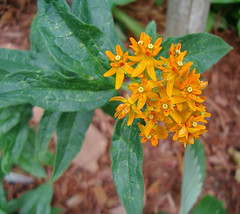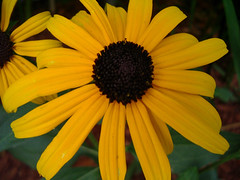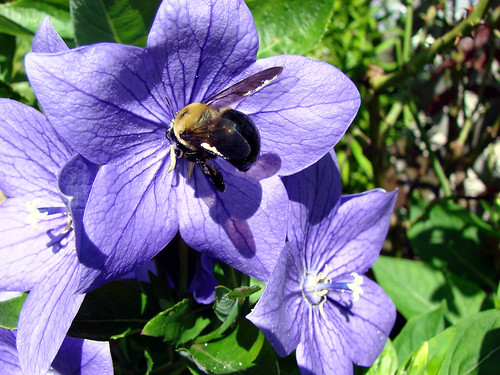Asclepias tuberosa
Native plant
 Height: 2-3 feet (60 to 90 cm)
Height: 2-3 feet (60 to 90 cm)
Blooming period: mid-summer
Exposure: full sun to light shade
Moisture: dry to average; drought tolerant
Habitat: prairies and meadows
Range: Prairies and Northeastern areas of North America
Description: Butterfly weed is one of the top butterfly attracting plants around. If one of the goals of your garden is to attract butterflies then this plant is a must. Clusters of orange flowers are borne at the top of 2 to 3 foot (60 to 90 cm) stems; leaves are narrow and dark green. Plants get bushy if they’ve got lots of room and, if crowded, stay narrow, straining for the sun. The seed pods are also very striking, large pods (4 to 6 inches/ 10 to 12.5 cm).
Maintenance and Requirements:
Butterfly weed prefers well-drained soil and will tolerate a broad range of conditions, from sand to clay, slightly acidic to neutral soil. Don’t let young seedlings dry out, but once established, plants are very drought tolerant. Butterfly weed emerges quite late in the spring, so be careful not to cultivate around it, as it doesn’t like disturbance.
Propagation:
Easy to start from seeds, which mature in Autumn. When seedlings are of transplantable size, place them in their permanent home, as butterfly weed’s long taproot resents being moved. You can also divide rootstalk in early spring or fall.
Good Companions:
Butterfly weed looks wonderful with almost any summer-blooming prairie natives, especially Blazing star (Liatris spp.), Prairie phlox (phlox pilosa), and Leadplant (Amorpha canescens), but for something a bit different, try planting it at the edge of a woodland garden, in a place where it will get sun. Also looks great with June grass (Koeleria cristata), which grows in clumps 1 to 2 feet (30 to 60 cm) tall and has fuzzy, spiky seedheads.
Related Species:
Though the common milkweed (A. syriaca) is a much-maligned plant, many of the milkweed species are not only very controlled plants, but are also very good candidates for prairie and northeastern gardens. One of the most graceful is whorled milkweed (A. verticillata), which has very slender leaves and airy clusters of small white flowers for many weeks in the summer.
Wildlife:
Milkweeds are the larval host plant for the Monarch butterfly and also the Queen butterfly. Their nectar attracts many other butterfly species and bees.


